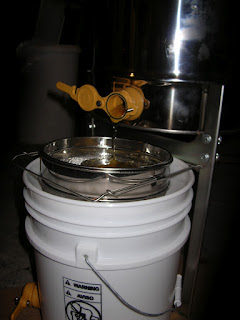But yesterday was the day to extract all the honey from the first 10-frame super. This is my season's crop, along with the honey from the other. I got at least 3 gallons of honey this year since it's now in a 5-gallon bucket and the honey comes up to within 5 inches of the top of the bucket.

Now the honey will sit in the covered bucket for a week. This is to allow any air bubbles to dissipate before putting into jars.
I'm very happy with this crop since I had no idea what to expect this first year. Beekeepers who only bought a package of bees may get nothing this year. I bought a nuc and did that hoping to get some honey this first year. It is certainly enough to give as gifts to family, friends and neighbors...plus me, of course! And next year, increasing to two hives, will give me more and then maybe I can begin selling a bit.
The rest of the honey in the hive is for the bees during the winter. So now, I will just keep giving them sugar syrup and they will fill up those two frames during the remainder of the season. And I will begin to gather hay, roofing paper to begin preparing some insulation for the winter.
Once the bear go into hibernation, I can also take down the electric fence for the winter and bring it inside. They recommend not leaving it in an unheated shed because it won't last as long.
Ouch, ouch, ouch
Of course, live and learn. With my new beekeepers suit that looks like a space suit, I had bees flying all around me. They weren't all that happy about me taking their honey! I did not get stung.
After the extraction, I had been told that the bees will clean off all the honey from the extracted frames so I decided to go put them back into the empty super. Which I did. The bees loaded these frames immediately to clean them off. But when I lifted it to place on top of the other super on the hive, it had a big gap...I had put the frames in an upside down box so I had to remove them all and flip over the box.
The bees went crazy and found my weakness...just where the sock goes into the sneaker is a vulnerable spot. Basically it's the only spot that isn't covered by something that keeps bees from getting to your skin. So I got stung around the ankles several times. Sigh. They swelled up last night and are very itchy at this moment.
But other than that, it all went very smoothly.
Then that big extractor needed to be cleaned so it went into the shower with me!
Steps to extracting honey
1. Purchase a triangle board and put it triangle side down under the super where you want to take the honey.
With this board, the bees leave the super and can't get back it. It honestly worked. I put it on at 5:00 PM Friday night and went to get the bees at around noon on Saturday. There were only a handful of bees left on the frames so I used a bee brush to brush them off and put the frame into the big plastic bucket used for uncapping and quickly covered it. Until all the 10 frames were in the covered sstorage-like container. I had placed the bucket on a little red wagon and wheeled it over to the porch. I then slid the container onto the porch, put the wagon on the porch, lifted the bucket back onto the wagon, and right into the kitchen where the uncapping took place.
2. Uncap each of the frames. You can use a hot knife for this, but because I had 10 frames in the hive, the comb wasn't built out beyond the frames so an uncapping tool is what I used. It's a pronged tool that looks like this:
You put your full frame of honey over this extraction tank that comes in three pieces. A cover, a bucket with a metal slatted bottom to catch the wax but allow the honey to flow into the bottom bank that has a spout.
 The piece of wood you see across the top if this has a screw in the middle that you rest the frame on as you are running the comb down over the frame to allow the honey to flow.
The piece of wood you see across the top if this has a screw in the middle that you rest the frame on as you are running the comb down over the frame to allow the honey to flow.The top tank above fits into the bottom bank below.


Once the frames are uncapped, they are ready for the Extractor. My extractor holds 3 frames, it seems, since I couldn't seem to make it hold 6. You spin it for a few minutes and the honey flows to the bottom of the tank. Then, when you're done, you open the flow into a double strainer to strain out any wax capping, etc. and the final product is now in the bucket.
 |
| filtering honey into 5-gallon bucket with spout for pouring after honey sits for about a week |
 | |
| Filtering the honey through two sieves |
I have let the cappings strain into the lower tank all night so that today I will strain that little bit more honey into my bucket and it will rest there for a week or so. Then I will bottle it. I have been saving jars to recycle for this purpose to I will use what I have. I also have some small jelly jars that will be useful. What fun it will be to see these all up on a shelf.


No comments:
Post a Comment